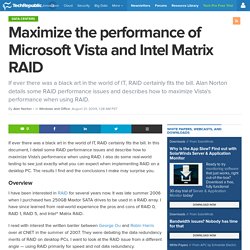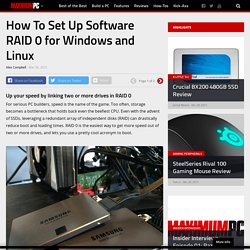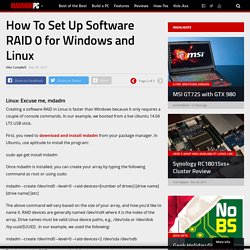

Maximize the performance of Microsoft Vista and Intel Matrix RAID. If ever there was a black art in the world of IT, RAID certainly fits the bill.

In this document, I detail some RAID performance issues and describe how to maximize Vista's performance when using RAID. I also do some real-world testing to see just exactly what you can expect when implementing RAID on a desktop PC. The results I find and the conclusions I make may surprise you. Overview I have been interested in RAID for several years now. I read with interest the written banter between George Ou and Robin Harris over at CNET in the summer of 2007. I will be discussing RAID and Windows Vista on a desktop PC, though the concepts apply to all versions of Windows from Windows 2000 on (for the purists out there — NT 4.0 Workstation supports RAID 0). If you decide that RAID belongs on your desktop PC, then the most important considerations are which RAID level or levels to implement and which RAID level is best for the operating system.
This is the first of a two-part series. Install two windows version in raid 0 parallel - Recherche Google. Multi OS on RAID 0 array. Dual Boot+FakeRAID+MBR & GPT Partitions on the same Array? Is this doable? SkOrPn June 18th, 2014, 07:12 PM Hi oldfred, sorry about the boot repair comment being worthless, I am a kind soft spoken person, but when something does not go well, I get cranky especially when I am up several hours past my usual bed time, lol...

Here is the BootInfo As I said in the OP, I do NOT have a UEFI or EFI system, it is BIOS only. I do not know if GPT was used or not since I let gparted do all the partitioning at first. I'm wondering if I should just enable the secondary SATA controller on the board and put two SSD's in AHCI mode and give Ubuntu what it want's, software RAID. Oh and another thing, I gave up on mdadm, and just used dmraid. Here in a bit I will try again and post the BootInfo report. How To Set Up Software RAID 0 for Windows and Linux - Maximum PC. Up your speed by linking two or more drives in RAID 0 For serious PC builders, speed is the name of the game.

Too often, storage becomes a bottleneck that holds back even the beefiest CPU. Even with the advent of SSDs, leveraging a redundant array of independent disks (RAID) can drastically reduce boot and loading times. RAID 0 is the easiest way to get more speed out of two or more drives, and lets you use a pretty cool acronym to boot.
In our test rig, we used a pair of Samsung 840EVOs with the latest firmware. RAID has several “levels” that use drives in different ways. On the plus side, RAID 0 combines the drives into a single larger logical drive with a capacity that is the sum of all the drives in the array. There are three ways to implement RAID: hardware, software, and FakeRAID. 2 ssd in raid0 / how to install windows 8.1 on them. How to Set Up 2 SSDs in RAID 0 when Windows 8 is Already Installed. How To Set Up Software RAID 0 for Windows and Linux. Up your speed by linking two or more drives in RAID 0 For serious PC builders, speed is the name of the game.

Too often, storage becomes a bottleneck that holds back even the beefiest CPU. Even with the advent of SSDs, leveraging a redundant array of independent disks (RAID) can drastically reduce boot and loading times. RAID 0 is the easiest way to get more speed out of two or more drives, and lets you use a pretty cool acronym to boot. In our test rig, we used a pair of Samsung 840EVOs with the latest firmware. RAID has several “levels” that use drives in different ways. On the plus side, RAID 0 combines the drives into a single larger logical drive with a capacity that is the sum of all the drives in the array.
There are three ways to implement RAID: hardware, software, and FakeRAID. Hyperlink. Software RAID, aka Soft RAID, Set Up.